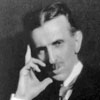On Becoming More Creative
 by Jack Foster
by Jack Foster
There are many ways of developing creativity.
Here are just two:
1) Gathering Input
2) The Courage to Move Outside of the Box
Let’s start with:
Gathering Input
Over the years I have worked with hundreds of creative people in advertising agencies. These were people who got ideas for a living. On demand. Every day.
They came in all shapes and sizes and colors and signs and personalities. One had a doctorate in anthropology, one never got past third grade. They came from close families and from broken homes, from penthouses and from ghettos. I worked with gays and straights, with extroverts and introverts, with flashers, drunkards, suicidals, ex-priests, ex-touts—the list goes on and on.
But they all had two characteristics in common.
First, they were courageous, a subject I will discuss later.
Second, they were all extremely curious. They had an almost insatiable curiosity about how things work and where things come from and what makes people tick.
They were curious about pie-making machines and flower drying, about Aztec burial customs and motorcycle design, about phobias and limes.
They knew things like the name of the horse Napoleon rode at Waterloo (Marengo), how many times egg whites increase in size when whipped (seven), how much a ten-gallon hat holds (three-quarters of a gallon), and the average number of times African elephants defecate every day (sixteen).
Most came about this curiosity naturally. All their lives they had, as one person put it to me, “the need to know.” In some, this need was so overpowering that they came to think of it as a curse instead of a blessing. They were wrong.
For their curiosity was one of the reasons they were able to come up with ideas in the first place. Their curiosity was forcing them to continually accumulate bits of knowledge–“general knowledge about life and events”–the “old elements” that James Webb Young talked about.
And someday they’ll combine those elements with other elements to create an idea. And the more elements they have to combine, the more ideas they can create.
After all, if “a new idea is nothing more nor less than a new combination of old elements,” it stands to reason that the person who knows more old elements is more likely to come up with a new idea than a person who knows fewer old elements.
If you do not have a natural curiosity that forces you to accumulate bits of knowledge, you must force yourself.
Every day. Deliberately.
Every day since he was 12, Ray Bradbury once told me, he read at least one short story, one essay, and one poem. Every day. He said he never knows when something he read 20 years ago will “collide” (his word) with something he read yesterday to produce an idea for a story.
When was the last time you read a short story or an essay or a poem? Is it any wonder Ray Bradbury comes up with more story ideas then you do?
Here are two ways to force yourself to get more old elements:
GET OUT OF YOUR RUT
Of course you’re in a rut. Admit it.
Why do you think you do the same things the same way in the same order every morning when you wake up? Or have the same thing for breakfast every day? Or go to work the same way every day? Or always read the same parts of the newspaper? Or always buy the same things at the supermarket? Or always watch the same TV programs? Or eat the way you eat, or dress the way you dress, or think the way you think, or, or, or?
It’s because you’re in a rut.
And because you’re in a rut, every day your five senses are recording the same things they recorded yesterday—the same sights, the same feelings, the same smells, the same sounds, the same tastes.
Oh sure, different things creep in every now and then. You can’t help it. Not even a deaf, blind hermit can keep out new sensations.
But they creep in, in spite of what you’re doing not because of what you’re doing.
And if you just stay in your rut and let things creep in naturally you’ll never pile up the kind of varied and extensive database you need to form new ideas.
There’s a huge, fascinating, exploding world of information out there—in any direction you care to look.
But you must look. And the sooner you do the sooner you’ll become aware of “old elements” you didn’t even know existed.
It is said that Andre Gide tried to read at least one book every month about a subject in which he had no interest. Have you ever done that? Do it. At least once.
Also:
Listen to a radio station you’ve never listened to before.
Study Latin.
Order something at a restaurant without knowing what it is exactly.
Read the label on a frozen pizza package. Read the want ads. Read Marianne Moore and Allen Ginsberg. Read a children’s book. Reread The Death of a Salesman. Read a magazine you’ve never heard of.
Check out something on the Internet you think you’ll dislike. See a play or a movie you think you’ll dislike. Rent a video you’ve never heard of.
Touch the bark of three different trees in your neighborhood. Learn to tell which is which simply by how it feels. Learn to tell which is which simply by how it smells.
Go to lunch with someone different.
Listen intently to music you don’t like.
Ride the bus for a week.
Learn to read music. Learn sign language. Learn to make quenelles. Learn to tie knots.
Take up watercolor painting.
Study Greek. Or Chinese. Or English.
Visit a store, a gallery, a museum, a restaurant, a market, a mall, a building, a place you’ve never visited before.
Of course I’m not saying to do all of these things.
But please, today, do something. Something different, something that will get you off dead center, something that will start you in a different direction, something that will get you out of your rut.
“If you want to be creative,” Louis L’Amour said, “go where your questions lead you. Do things. Have a wide variety of experiences.”
A writer friend of mine in Los Angeles lived about 10 miles from his office. It was a straight shot, right down Wilshire Boulevard from Westwood to downtown. But he never once took Wilshire. Indeed, every weekday morning for nine years he drove to work a different way. Never once, he claims, did he go the same way. “Admittedly, there were times when I had to do some pretty crazy things to keep from taking the same route,” he remembers. “I had to drive down alleys, and wander through residential areas, and get on freeways going away from where I wanted to go. But I never repeated myself. And I bet I saw more of Los Angeles in those nine years than most people will see in their lifetimes.”
In what way are you richer than my friend because you go to work the same way every day?
Every day he saw something he never saw before. Every day you see the same things you saw yesterday. He was constantly seeing new things. You are constantly seeing the same old things.
Tomorrow go to work a different way. And a different way the next day. And the next. Forever.
LEARN HOW TO SEE
Back before the Second World War my dad and mom and I used to drive from Evanston, Illinois, to my mom’s parents’ house in Danville, Illinois. We went every month or so. It was about a two- or three- hour trip on those days. Sometimes we played a game called “White Horse” on the way. It was a simple game really—the first person to spot a white horse by the side of the road or way back off in some pasture said, “White Horse,” and at the end of the trip the one who spotted the most white horses first won the game.
Now the interesting thing I remember about that game is that when we played it we saw all sorts of white horses. But when we didn’t play the game we hardly saw any at all.
Why?
It wasn’t because there were all sorts of white horses around when we were playing and only a couple around when we weren’t.
It was because when we were looking for those white horses we saw them; when we weren’t, we didn’t.
The same thing happens when you just buy a car, or even if you’re just thinking about buying a car. All of a sudden you start seeing cars like that all over the place.
They were always there before. You just didn’t see them because you weren’t looking for them. But as soon as you got interested in that particular car you started—consciously or not—looking for them. And voila, there they were.
And what’s true about white horses and cars is true about everything.
For you see everything that comes in contact with your eyes.
You see every car that you passed on the way to work this morning. And every car that passed you. And every driver in every car that you passed or that passed you.
You see every tree and bush and patch of grass you passed too. And every telephone pole, every gas station, every building, every traffic light, every person, every street lamp, every mailbox, every everything.
Then how come you can recall only a fraction of what you see?
It’s because weren’t really seeing. You were simply looking. Not looking for, just looking. Looking requires no effort at all. It’s as easy as breathing. Seeing is different; it requires effort. And commitment.
But hear this: Once you get the hang of it, seeing becomes almost as natural as looking.
By working at it you can see more and remember more of what you see than you ever dreamed you could. You can remember more about the people you meet and the places you go and the things you read.
And the more things you remember, the more things you’ll have to combine in order to form new ideas.
But you must work at it. Every day.
Here’s how to start:
Tomorrow morning on your way to work, or on your first coffee break, buy yourself a notebook. Not a loose-leaf notebook. Buy a ledger—something with a sense of permanence to it. Then every day write in it something that you’ve seen. Every day. It doesn’t make any difference what you see; only that you see something and record it. (If you also want to write what you think about what you see, feel free. After all, that’s what Thomas Wolfe and hundreds of other writers did and do.)
When your ledger is full, sit down and read it. Then start filling up another one. And another one. And another one.
For the rest of your life.
BECOMING COURAGEOUS
Secondly, let’s talk about the courage to move outside the box.
As I said, courage and curiosity are the two character traits all creative people seem to have.
Why do some people have these two traits (courage and curiosity) and others don’t? And what can you do about it if you don’t?
“An idea is delicate,” said Charles Brower, the head of an advertising agency. “It can be killed by a sneer or a yawn; it can be stabbed to death by a quip and worried to death by a frown on the right man’s brow.”
I think this is why many people seem bereft of ideas.
They’ve run into too many sneers and yawns, they’ve heard too many quips. And so they’ve said the heck with it and don’t even try to come up with ideas any more.
The fear of rejection shuts down their idea factories.
I can’t tell you how to get enough courage to push ahead, to ignore the doubts and raised eyebrows and pooh-poohing you get when you tell people what you’ve got in mind.
All I know is that you must.
It will help to remember five things:
EVERYBODY’S AFRAID—EVERYBODY
The more naturally creative you are the more fear you probably feel, for your antennae are more finely attuned and you’re more aware of what other people are thinking, more sensitive to their feelings, more affected by their actions. So it’s only natural that you should get uptight and feel antsy and be afraid.
In the face of such fear it takes courage to speak out.
For courage—as Kierkegaard and Hemingway and Nietzsche and Sartre and Camus and others point out—is not the absence of fear. It is going ahead in spite of the danger, in spite of being afraid or feeling despair.
“Creativity is dangerous,” writes Robert Grudin in The Grace of Great Things.
“We cannot open ourselves to new insights without endangering the security of our prior assumptions. We cannot propose new ideas without risking disapproval and rejection.”
Just remember, though, that the people who sneer or quip are afraid too. Afraid of your ideas.
That is often why they sneer and quip.
After all, ideas by their very nature are potentially destructive. They can change things. And the more original the ideas, the more radical the changes. And the more changes they wreak, the more it threatens people, the more it makes them question their beliefs and actions, the more it makes them anxious about their jobs and their futures.
So next time fight through your fear and blurt out your idea. If for no other reason than to make the other guy afraid.
THERE ARE NO BAD IDEAS
Madam Curie had a “bad” idea that turned out to be radium.
Richard Drew had a “bad” idea that turned out to be scotch tape.
Joseph Priestley invented carbonated water while he was investigating the chemistry of the air.
Blaise Pascal invented roulette while he was experimenting with perpetual motion.
Vulcanized rubber was discovered by accident by Goodyear. So was anti-knock gasoline by Kettering. So was electric current by Galvani. So were potato chips by an unknown chef at a Saratoga Springs hotel. So was immunology by Pasteur. So were X-rays by Roentgen. So was the telescope by Lippershey. So was practical photography by Daguerre. So was radioactivity by Becquerel. So were friction matches by Walker. So was penicillin by Fleming.
The moral? Never cry over spilled milk. Find a use for it. Or invent a better milk carton.
YOU CAN ALWAYS GET ANOTHER IDEA—PROBABLY EVEN A BETTER ONE
In advertising, for instance, your ideas are always being turned down. It’s the nature of that business.
And when they are turned down you grouse about it. You bitch and complain and swear and make idle threats and have too much to drink at lunch or go home early and yell at your kids.
Ralph Price, an advertising agency art director I used to work with, had a different reaction, one that I’ve tried to acquire over the years.
“Rats,” I’d say while leaving the client’s building. “That was a great campaign they just turned down.”
“Wow, this is super!” Ralph would say. “Now we can do a really great campaign.”
You see, Ralph not only knew there was always another idea, he knew there was always a better idea.
If there wasn’t, what were we doing in the advertising business? It was our job to come up with ideas. And if we couldn’t beat our last idea—if our last idea was the best we could ever come up with—then we might as well quit, for we were on our way down, and pretty soon our bosses would get somebody who could come up with a better idea.
So Ralph never looked at a rejection as a defeat. It was always an opportunity to do something better.
But even if you can’t emulate Ralph when your idea somehow doesn’t work, remember that at least you’ve found out what doesn’t work, and that should help you get an idea that does.
It certainly helped Edison. In attempting to make a light bulb he tried over a thousand ideas before he hit the one that worked.
Ray Bradbury wrote at least one short story every week for ten years before he wrote one that made the hair on his neck stand up.
Kepler spent nine years and filled 9,000 folio sheets with calculations in his small handwriting trying to work out the orbit of Mars before he concluded that the paths of the planets were not circular but elliptical.
So don’t think that your idea is the end of the line. It’s the beginning of another line.
NOBODY’S EVER CRITICIZED FOR GETTING TOO MANY IDEAS
Perhaps one of the things that is inhibiting you is the fear that your reputation, your future even, is riding on the idea you are about to suggest.
Perhaps it is, perhaps the sky will fall, perhaps people will laugh at you, or perhaps your idea won’t work and will ruin the company you work for and you’ll get fired and your family will disown you and you’ll die a pauper and a failure.
OK then, don’t place all your dreams on one idea. Come up with a lot of ideas. That way you’ll be known as “that genius with all the ideas” instead of “that jerk with the one lousy idea.”
GETTING AN IDEA IS WORTH IT
It’s a great feeling—swinging for the fences and connecting.
There’s nothing quite like it. You’re sitting in a room trying to come up with an idea, a solution, a way to go, and nothing is happening, and there is nothing there but walls and barriers and closed doors and stop signs and dead ends, and you’re frustrated and worried and wondering if you’ll ever find a way out of this maze, this box, this trap, when all of a sudden it hits, and wham—you see the whole thing, all at once, solved, with everything fitting and working together. Wheee.
“Creative achievement is the boldest initiative of the mind,” said Robert Grudin, “an adventure that takes its hero simultaneously to the rim of knowledge and the limits of propriety.
“Its pleasure is not the comfort of the safe harbor, but the thrill of the reaching sail.”
Swing for the fences. Go for broke.
Compared to a reaching sail, a safe harbor is pap.
Excerpt from How To Get Ideas
Posted in Other Topicswith comments disabled.





